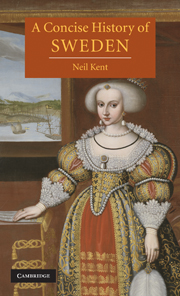Book contents
- Frontmatter
- Contents
- List of illustrations
- Maps
- Preface
- 1 From prehistory to Viking hegemony
- 2 The formation and growth of the Swedish state
- 3 The territorial consolidation of Sweden
- 4 Towards a centralist and military state
- 5 The collapse of absolutism and the Age of Freedom
- 6 Royal absolutism restored
- 7 Constitutional Sweden
- 8 The industrialisation and capitalisation of Sweden
- 9 The world wars and Swedish neutrality
- 10 Triumph of the Swedish welfare state
- Conclusion
- Appendix 1 Chronology
- Appendix 2 Monarchs and regents of Sweden
- Appendix 3 Prime ministers
- Selected further reading
- Index
2 - The formation and growth of the Swedish state
Published online by Cambridge University Press: 05 June 2014
- Frontmatter
- Contents
- List of illustrations
- Maps
- Preface
- 1 From prehistory to Viking hegemony
- 2 The formation and growth of the Swedish state
- 3 The territorial consolidation of Sweden
- 4 Towards a centralist and military state
- 5 The collapse of absolutism and the Age of Freedom
- 6 Royal absolutism restored
- 7 Constitutional Sweden
- 8 The industrialisation and capitalisation of Sweden
- 9 The world wars and Swedish neutrality
- 10 Triumph of the Swedish welfare state
- Conclusion
- Appendix 1 Chronology
- Appendix 2 Monarchs and regents of Sweden
- Appendix 3 Prime ministers
- Selected further reading
- Index
Summary
THE CONSOLIDATION OF CHRISTIANITY IN SWEDEN
By the end of the first quarter of the twelfth century, the Catholic Church was firmly established in Sweden. In 1120, the permanent presence of a bishop on Swedish soil was finally secured and other seats were formally established throughout the country, at Linköping, Strängnäs, Västerås and Eskilstuna, even if the episcopal incumbents were not necessarily in residence. Few of them were, in any case, Swedish at this time, for most of the country’s early missionary bishops were foreigners, predominantly English or, in other cases, German. Some suffered martyrdom, like Eskil, the ‘apostle’ of Södermanland, in whose honour the see of Eskilstuna was named. English and German Catholicism thus came to exert a significant influence on the Swedish Church in its early days, furthering cultural and economic links in the process. The foreign churchmen were, also, particularly useful in introducing coherent legal codes and administrative practices modelled on those in their native lands. Especially important, in this regard, was the evidential stress they gave to written documentation, in confirmation of land grants or other forms of voluntary donations. This paved the way for a judicial system, which further served to assist the growth of the Swedish state itself.
Swedish architecture at this time was almost exclusively dependent upon local building materials, in particular wood, even if many stylistic influences also came from abroad. Most of the early churches in Sweden, therefore, were, not surprisingly, built of wooden staves, but already by the beginning of the twelfth century, stone ones like that at Sigtuna were constructed, often based on Anglo-Norman models. This situation was in contrast to that of Scania, in the south, still under Danish hegemony, where churches tended to follow German models, in particular church design from the Rhineland.
- Type
- Chapter
- Information
- A Concise History of Sweden , pp. 16 - 48Publisher: Cambridge University PressPrint publication year: 2008



